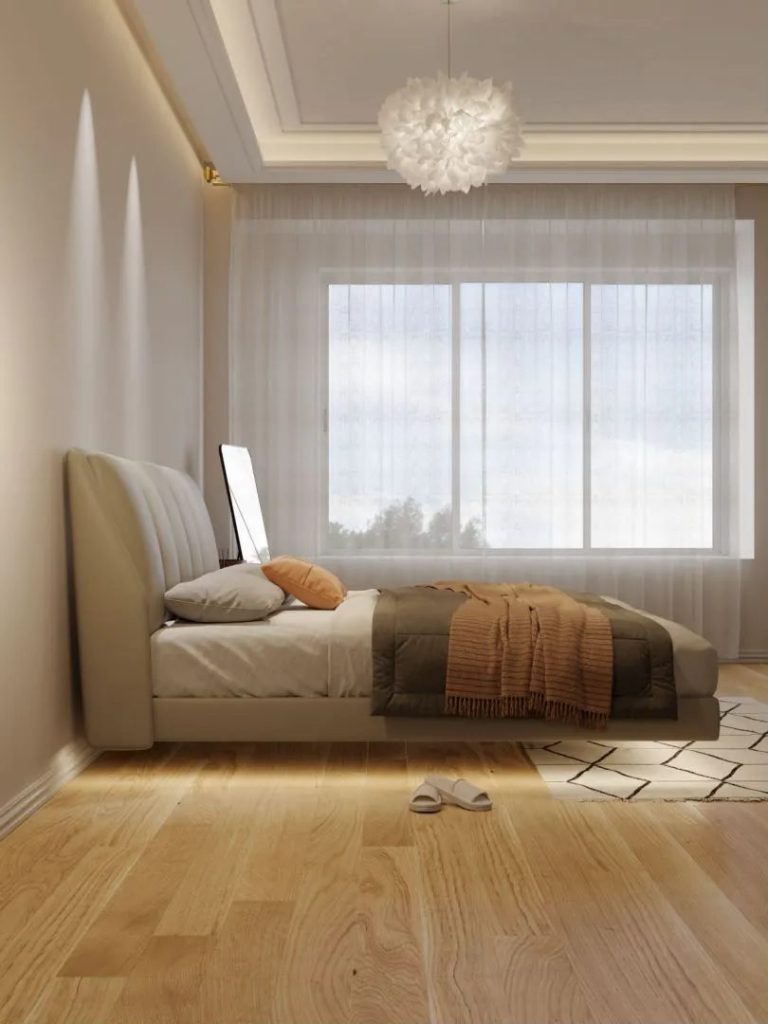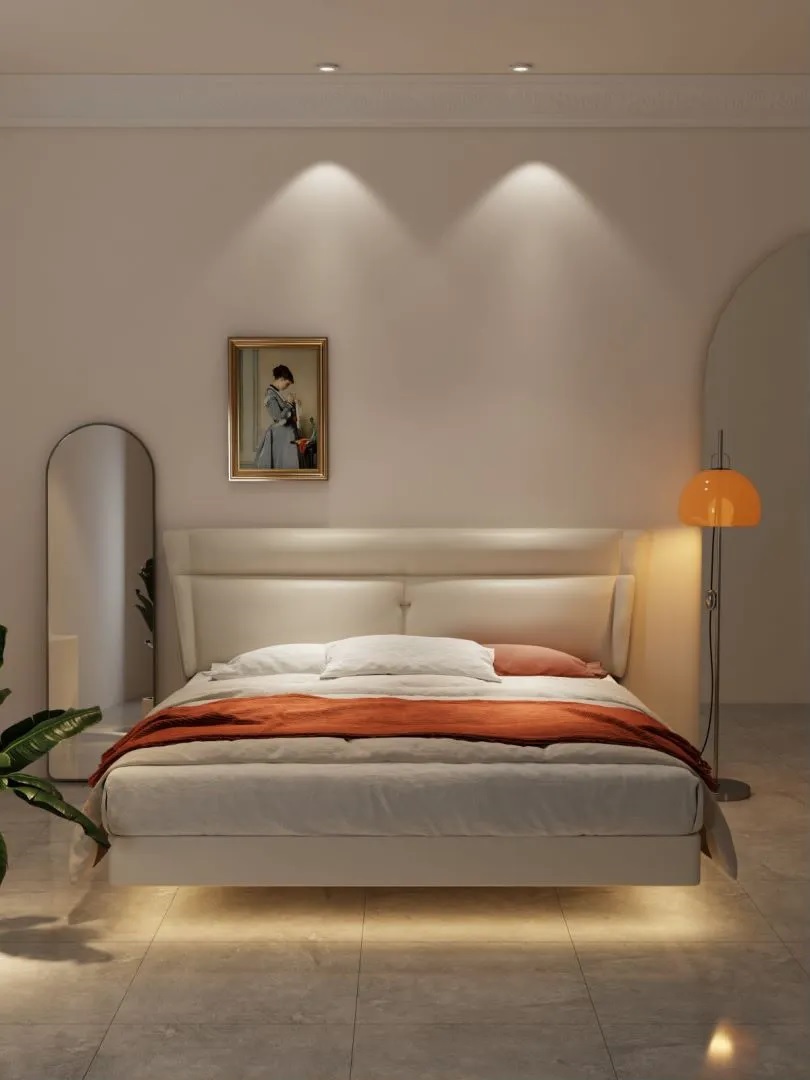Choosing the right bed frame is essential for creating a comfortable and aesthetically pleasing bedroom. One popular option that has gained attention in recent years is the floating bed frame.
These unique bed frames create the illusion of a suspended bed, adding a touch of modernity and elegance to any space. In this article, we will discuss the pros and cons of floating bed frames, helping you determine if they are the right fit for your bedroom.
The Pros of Floating Bed Frames

1. Aesthetically Pleasing:
Floating bed frames add a touch of elegance and sophistication to any bedroom. Their clean lines and minimalist design create a sense of spaciousness, making them perfect for small or cluttered rooms. The floating effect can also give your bedroom a unique and eye-catching focal point.
2. Space-Saving Design:
One of the major advantages of floating bed frames is their space-saving design. By eliminating the need for a bulky box spring or traditional bed frame, you can maximise the usable space in your bedroom. This is particularly beneficial for those living in small apartments or rooms with limited square footage.
3. Easy Cleaning and Maintenance:
Unlike traditional bed frames, floating bed frames are typically easier to clean and maintain. With no need to move heavy mattresses or deal with hard-to-reach spaces, cleaning becomes a breeze. Additionally, the absence of dust-prone areas underneath the bed reduces the likelihood of allergies and makes cleaning a more straightforward task.
4. Versatility
Floating bed frames come in a variety of designs, materials, and finishes, allowing you to find the perfect match for your bedroom decor. Whether you prefer a rustic wooden frame or a sleek metal design, there is a floating bed frame to suit every taste and style.
5. Enhanced Comfort
Floating bed frames often provide excellent support for mattresses, offering a comfortable and restful sleep experience. The absence of a box spring allows for a more flexible and responsive surface, which can contribute to better spinal alignment and pressure point relief.
6. Customizable Height
With floating bed frames, you have the flexibility to adjust the height of your bed according to your preferences. This feature is particularly useful for individuals with mobility issues or those who find it easier to get in and out of beds at a specific height.
7. Durability and Longevity
Many floating bed frames are constructed from high-quality materials, such as solid wood or sturdy metal, ensuring their durability and longevity. These frames are designed to withstand regular use and are often more resistant to wear and tear compared to traditional bed frames.
8. Noise Reduction
Floating bed frames can help minimise noise disturbances during sleep. By eliminating the squeaks and creaks that often come with traditional frames, you can enjoy a quieter and more peaceful sleeping environment.
9. Adjustable Firmness
Certain types of floating bed frames, such as those with adjustable slats or platforms, offer the advantage of customizable firmness. You can modify the level of support and firmness by adjusting the slats or adding a mattress topper, allowing you to find the perfect balance for your comfort.
The Cons of Floating Bed Frames

1. Limited Storage Options:
One of the drawbacks of floating bed frames is the limited storage options they offer. Since the frame is elevated and does not have space underneath, you may need to find alternative storage solutions for items such as extra bedding or seasonal clothing. However, some floating bed frames come with built-in drawers or shelves, mitigating this issue to some extent.
2. Weight Limitations:
Floating bed frames typically have weight limitations due to their design. It’s crucial to check the weight capacity specified by the manufacturer to ensure the frame can support the combined weight of the mattress, bedding, and individuals using the bed.
3. Assembly and Installation:
Depending on the complexity of the design, floating bed frames may require more effort and time for assembly and installation compared to traditional bed frames. It is important to carefully follow the manufacturer’s instructions or seek professional help to ensure a secure and stable setup.
4. Limited Durability
Floating bed frames may have reduced durability compared to traditional bed frames. The lack of support from the ground can put more strain on the frame, especially if it is made of materials that are not sturdy or durable. Over time, this can lead to wear and tear, potentially reducing the lifespan of the bed frame.
5. Height Accessibility
While the elevated design of floating bed frames can be visually appealing, it may not be suitable for everyone, particularly individuals with mobility issues or disabilities. Getting in and out of a higher bed may be more challenging and require additional assistance or modifications.
6. Noise and Movement
Floating bed frames can be prone to noise and movement. The suspended design may result in increased creaking or shifting of the frame, especially during restless nights or when multiple people are using the bed. This can potentially disrupt sleep and affect overall comfort.
7. Limited Style Options
Although floating bed frames offer a unique and modern aesthetic, they may not be available in a wide range of styles or designs compared to traditional bed frames. If you have a specific interior design theme or preference, finding a floating bed frame that complements your style may be more challenging.
8. Price
Floating bed frames tend to be more expensive than traditional bed frames. The innovative design and materials used in their construction can contribute to a higher price point. If you have budget constraints, a floating bed frame may not be the most cost-effective option for you.
FAQs
1. Are floating bed frames suitable for all mattress types?
Yes, floating bed frames are compatible with various mattress types, including memory foam, innerspring, and hybrid mattresses.
2. Can I attach a headboard to a floating bed frame?
Some floating bed frames come with pre-drilled holes or brackets for attaching a headboard. However, it’s important to check the specifications of the specific bed frame you choose to ensure compatibility with a headboard.
3. Are floating bed frames more expensive than traditional bed frames?
Floating bed frames can vary in price depending on the material, design, and brand. While some may be more expensive than traditional bed frames, there are also affordable options available in the market. It’s important to consider your budget and compare prices before making a purchase.
4. Can floating bed frames accommodate adjustable beds?
Not all floating bed frames are suitable for adjustable beds. It’s essential to check the product description or consult with the manufacturer to ensure compatibility with an adjustable bed base.
Summary
Floating bed frames offer a stylish and modern solution for creating an elegant bedroom space. With their aesthetic appeal, space-saving design, and easy maintenance, they have become a popular choice among homeowners.
If you’re looking for a floating bed frame to enhance the ambiance of your bedroom, CUURA Space offers affordable options that cater to various sizes, ranging from queen to king. Their selection includes a variety of styles to suit different preferences and interior designs.

